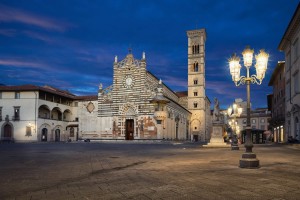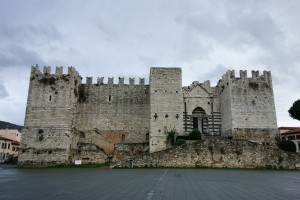
©Bigstock.com/bbsferrari
There are many stunning cities of arts in Tuscany, each with their own enthralling history and unique architectural diversity, attracting countless visitors from all over the world year after year. However, many seem to forget the second-largest city of the region, certainly in part due to the close proximity to Florence. Prato is only 17 km away, has around 195,000 inhabitants and is actually an almost magical city of arts in its own right with a wealth of attractive palaces and churches around the pedestrian zone in the city centre. Add the countless stores and boutiques, especially fashion and textiles, and the excellent regional cuisine into the mix and you get a must-visit destination. We tell you what awaits you in the north of Tuscany.
The origins of the industrial centre Prato
Prato’s history is told quickly. Early settlements date back to the Old Stone Age. The Etruscans traded wool and textiles, but the region quickly lost any significance. Prato’s actual history started in the 10th century with the first mention of the two villages Borgo al Cornio and Castrum Prati. They were united by the Alberti family who received the title “Counts of Prato” and helped the now drained region with river water supply become a wool and textile emporium. Francesco Datini created his massive trade empire here during the second half of the 14th century and left behind the biggest archive of merchant administration of the Late Middle Ages – a collection of over 152,000 documents and other trade related correspondence.
Prato was already part of the Republic of Florence at that point having been sold by Joanna I of Naples for 17,500 gold coins. It was given official city status in 1653 with rich embellishments and adornments to reflect this new level and wealth added in the following century. The city became an important industrial centre, especially in the textile sector, after the unification of Italy. Immigration grew exponentially – first from southern Italy, later from other countries with a substantial Chinese community currently living in Prato.
Prato’s churches and cathedrals
The high number of ecclesiastical buildings in Prato – a striking characteristic for many cities in Tuscany – is quite noticeable. We have handpicked seven particularly interesting churches and cathedrals for your visit:
- Duomo di Prato: The roots of the city cathedral likely date back to the 5th century, but today’s façade made of white Alberese marble and green Serpentino marble was actually built during the Late Middle Ages. Behind the massive portal there’s a three-nave basilica minor with an astonishing cycle of frescoes by Filippo Lippi.
- Santa Maria delle Carceri: Prato’s second basilica minor, however, was only built during the Renaissance period. Utilising the strict principles of the Greek cross shape, you get to experience an impressive, highly typical depiction of this era’s style and norms although part of the façade were never completed.
- Sant’Agostino: Admittedly, the fairly plain façade with its rose window and belltower isn’t overly alluring. You should definitely peek inside to see numerous highly precious and artistic canvasses and frescoes.
- San Domenico: Fine arts take centre stage as well in San Domenico as the church is home to stunning paintings by Matteo Rosselli. Don’t skip the adjacent museum with its wall frescoes!
- San Francesco: Most of the baroque decoration in the interior was removed in the early 20th century to unearth the medieval roots. Niccolò Gerini’s frescoes in the chapel alone make this church worth a visit.
- San Fabiano: One of Prato’s oldest still existing churches was first documented in 1082. The mosaic floor is even older and was made from the 9th to the 11th
- Santi Vincenzo e Caterina de’ Ricci: The original 16th century church built for an adjacent monastery was a fairly simple matter. It saw a full overhaul after the beatification of Caterina de’ Ricci. The remains of the saint are exhibited beneath the main altar. The church is vested in amazing sculptures and ceiling paintings.
The palaces and museums
Sure, that’s already quite enough for a thrilling city tour, but Prato has so much more to offer. Here are a few additional ingredients for a tasty walk through the city of arts:
- Palazzo Pretorio: The old city hall, a merger of three separate buildings in the late 13th and early 14th century, still reveals the outlines of the former individual parts on the façade. It has been home to the amazing Museo Civico with a great art collection from the Middle Ages to the 19th century since 1912.
- Palazzo Datini: Remember Francesco Datini’s merchant archive? It was discovered in a wall of this very palace in the 19th These documents have since found a home in Prato’s State Archive which is in – you’ve probably already guessed it – Palazzo Datini. The ground floor with its paintings and mosaics was converted into a museum.
- Palazzo degli Alberti: Converted and extended multiple times, you can see traces of various construction periods from the 13th to the 19th century on the façade of this palace. The Palazzo art gallery is mainly dedicated to Tuscan baroque painting.
-

©Bigstock.com/Marcovarro
Castello dell’Imperatore: Frederick II, Holy Roman Emperor, had this castle built on an old fortification in central Prato. The northernmost fortress of his realm was never completed due to the emperor’s death. We recommend walking up the stairs to the fortress walls for a round tour including a gorgeous view of the city.
- Museo dell’Opera del Duomo: The old bishop’s residence of Prato now unites six different museum rooms dedicated to the city’s ecclesiastical history. Look forward to various statues, paintings and relics, some of which even date back as far as the 13th A tour of the vault beneath the cathedral is a must.
- Villa Medici: And finally we’re travelling to Poggio a Caiano about nine kilometres south of Prato. The Medici summer residence is widely regarded as the prototype of Renaissance villa architecture strongly inspired by the ancient villas described by Pliny the Elder and Vitruvius. The site with its partially geometric, partially English garden is now used as a large museum.
Prato is everything but non-descript and therefore wrongly neglected. The industrial centre in northern Tuscany has a lot of charm and absolutely should be part of your holiday plans. You will certainly soon fall under the spell of this friendly city of arts.